|
|
Canku Ota |
|
|
(Many Paths) |
||
|
An Online Newsletter Celebrating Native America |
||
|
August 24, 2002 - Issue 68 |
||
|
|
||
|
Why Kingfisher Wears a War Bonnet |
||
|
|
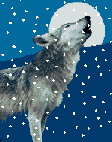 One
day in the winter-time when OLD-man and the Wolf were hunting. The snow
covered the land and ice was on all of the rivers. It was so cold that
OLD-man wrapped his robe close about himself and his breath showed white
in the air. Of course the Wolf was not cold; wolves never get cold as
men do. Both OLD-man and the Wolf were hungry for they had travelled far
and had killed no meat. OLD-man was complaining and grumbling, for his
heart is not very good. It is never well to grumble when we are doing
our best, because it will do no good and makes us weak in our hearts.
When our hearts are weak our heads sicken and our strength goes away.
Yes, it is bad to grumble. One
day in the winter-time when OLD-man and the Wolf were hunting. The snow
covered the land and ice was on all of the rivers. It was so cold that
OLD-man wrapped his robe close about himself and his breath showed white
in the air. Of course the Wolf was not cold; wolves never get cold as
men do. Both OLD-man and the Wolf were hungry for they had travelled far
and had killed no meat. OLD-man was complaining and grumbling, for his
heart is not very good. It is never well to grumble when we are doing
our best, because it will do no good and makes us weak in our hearts.
When our hearts are weak our heads sicken and our strength goes away.
Yes, it is bad to grumble.
"When the sun was getting low OLD-man and the Wolf came to a great river. On the ice that covered the water, they saw four fat Otters playing. "'There is meat,' said the Wolf; 'wait here and I will try to catch one of those fellows.' "'No!--No!' cried OLD-man, 'do not run after the Otter on the ice, because there are air-holes in all ice that covers rivers, and you may fall in the water and die.' OLD-man didn't care much if the Wolf did drown. He was afraid to be left alone and hungry in the snow--that was all. "'Ho!' said the Wolf, 'I am swift of foot and my teeth are white and sharp. What chance has an Otter against me? Yes, I will go,' and he did.
"Old-man saw it all and began to cry and wail as women do. Ho! but he made a great fuss. He ran along the bank of the river, stumbling in the snowdrifts, and crying like a woman whose child is dead; but it was because he didn't want to be left in that country alone that he cried--not because he loved his brother, the Wolf. On and on he ran until he came to a place where the water was too swift to freeze, and there he waited and watched for the Wolf to come out from under the ice, crying and wailing and making an awful noise, for a man.
"'There,' said OLD-man, 'I'll teach you to laugh at me when I'm sad. Your feathers are standing up on the top of your head now and they will stay that way, too. As long as you live you must wear a head-dress, to pay for your laughing, and all your children must do the same. "This was long, long ago, but the King-fishers have not forgotten, and they all wear war-bonnets, and always will as long as there are Kingfishers. Print and Color Your Own Kingfisher |
|
|
|
Belted Kingfisher
(Ceryle alcyon)
|
|
Belted Kingfishers, as their name suggests, subsist mostly on fish. However, they occasionally consume other prey, including crayfish, shellfish, squid, and terrestrial prey such as small birds, mammals, lizards, and insects. They have even been reported to eat berries when other food is unavailable. Belted Kingfishers typically sit at a waterside perch watching for suitable prey, usually small fish less than six inches in length. They make steep dives head-first into the water. They may hover and plunge vertically from heights of up to 50 feet into the water, occasionally disappearing completely for a few seconds. They catch most fish within two feet of the surface. To stop the dive, they spread their wings under water. After catching a fish, they will beat their prey on a perch to immobilize it, then toss it into the air and swallow it head-first. They may dismember other prey, such as crustaceans and insects, before consuming them. They disgorge indigestible parts of prey such as fish bones and scales, which may accumulate under favorite perches.
During the breeding season, Belted Kingfishers range as far north as the Aleutian islands, central Ontario and Labrador, and south throughout the United States as far as southern California, southern Texas and the Gulf Coast. In winter they occupy the West Indies and as far south as Panama and the northern coast of South America. Some remain in the summer range, as far north as they can find open water. Description: Belted Kingfishers are unlikely to be confused with any other bird. Their huge bill, large head with shaggy crest, and coloring are distinctive. They are large (11 to 13 inches long) with blue-gray head and upperparts contrasting with the white underparts. Both sexes have a white collar and broad band of blue-gray across the chest. Females have chestnut flanks (usually concealed below the folded wing) and a second chestnut band across the belly. The large head and bill contrast with the tiny legs and short tail, making Belted Kingfishers look top-heavy.
The kingfisher is a picturesque but hardly a handsome or pretty bird. Its head, helmeted with a crest of gray feathers, seems out of proportion with the rest of its body. Both sexes are chunky-appearing birds, grayish blue in color with a heavy band of blue across the chest of the male and a rust-colored stripe on the female. A sharp bill, longer than the bird's head, is used to spear its prey. With its heavily oiled plumage and a suit of down underwear, the feathered fisherman is probably more comfortably attired than his human counterpart. The eyesight of a kingfisher can be compared favorably with that of hawks and eagles. Its dives are made from fifteen to fifty feet and one can imagine the difficulty in spotting a two to three inch fish from such a distance in water that could range from murky to sunlit. The impact of the dive would seem to stun the piscatorial expert but he takes it in stride. Water temperatures also fail to deter the flying Isaac Walton who hits the icy waters of King Winter with the same nonchalance that he fishes in the balmy waters of summer. |
|
|
||
|
|
||
| Canku Ota is a free Newsletter celebrating Native America, its traditions and accomplishments . We do not provide subscriber or visitor names to anyone. Some articles presented in Canku Ota may contain copyright material. We have received appropriate permissions for republishing any articles. Material appearing here is distributed without profit or monetary gain to those who have expressed an interest. This is in accordance with Title 17 U.S.C. section 107. | ||
|
Canku Ota is a copyright © 2000, 2001, 2002 of Vicki Lockard and Paul Barry. |
||
 |
 |
|
|
The "Canku Ota - A Newsletter Celebrating Native America" web site and its design is the |
||
|
Copyright © 1999, 2000, 2001, 2002 of Paul C. Barry. |
||
|
All Rights Reserved. |
||
 "Away
ran the Otters with the Wolf after them, while OLD-man stood on the
bank and shivered with fright and cold. Of course the Wolf was faster
than the Otter, but he was running on the ice, remember, and slipping
a good deal. Nearer and nearer ran the Wolf. In fact he was just about
to seize an Otter, when SPLASH!--into an air-hole all the Otters went.
Ho ! the Wolf was going so fast he couldn't stop, and SWOW! into the
air-hole he went like a badger after mice, and the current carried him
under the ice. The Otters knew that hole was there. That was their country
and they were running to reach that same hole all the time, but the
Wolf didn't know that.
"Away
ran the Otters with the Wolf after them, while OLD-man stood on the
bank and shivered with fright and cold. Of course the Wolf was faster
than the Otter, but he was running on the ice, remember, and slipping
a good deal. Nearer and nearer ran the Wolf. In fact he was just about
to seize an Otter, when SPLASH!--into an air-hole all the Otters went.
Ho ! the Wolf was going so fast he couldn't stop, and SWOW! into the
air-hole he went like a badger after mice, and the current carried him
under the ice. The Otters knew that hole was there. That was their country
and they were running to reach that same hole all the time, but the
Wolf didn't know that.  "Well--right
there is where the thing happened. You see, Kingfisher can't fish through
the ice and he knows it, too; so he always finds places like the one
OLD-man found. He was there that day, sitting on the limb of a birch-tree,
watching for fishes, and when OLD-man came near to Kingfisher's tree,
crying like an old woman, it tickled the Fisher so much that he laughed
that queer, chattering laugh.
"Well--right
there is where the thing happened. You see, Kingfisher can't fish through
the ice and he knows it, too; so he always finds places like the one
OLD-man found. He was there that day, sitting on the limb of a birch-tree,
watching for fishes, and when OLD-man came near to Kingfisher's tree,
crying like an old woman, it tickled the Fisher so much that he laughed
that queer, chattering laugh. 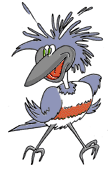 "OLD-man
heard him and--Ho! but he was angry. He looked about to see who was
laughing at him and that made Kingfisher laugh again, longer and louder
than before. This time OLD-man saw him and SWOW! he threw his war-club
at Kingfisher; tried to kill the bird for laughing. Kingfisher ducked
so quickly that OLD-man's club just grazed the feathers on his head,
making them stand up straight.
"OLD-man
heard him and--Ho! but he was angry. He looked about to see who was
laughing at him and that made Kingfisher laugh again, longer and louder
than before. This time OLD-man saw him and SWOW! he threw his war-club
at Kingfisher; tried to kill the bird for laughing. Kingfisher ducked
so quickly that OLD-man's club just grazed the feathers on his head,
making them stand up straight. 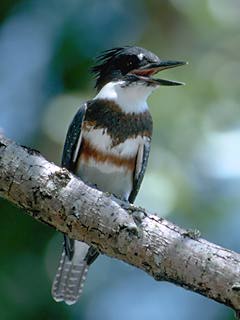 Belted
Kingfishers are one of a few species of North American birds whose females
are more colorful than males. Females have a chestnut band across the
belly that is absent in males.
Belted
Kingfishers are one of a few species of North American birds whose females
are more colorful than males. Females have a chestnut band across the
belly that is absent in males. 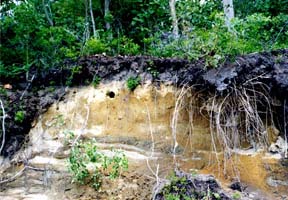 The
nest site of a Belted Kingfisher is almost always a tunnel excavated
near the top of a vertical bank. Nests may be several miles from fishing
grounds. Kingfishers may thus have to defend two territories, one for
feeding and the other for nesting. They prefer sandy soil at the nest
site, but they may use gravel pits and even the soil caught in the roots
of fallen trees if necessary. A pair takes turns digging a burrow three
to four inches in diameter using their beaks and feet until the nesting
chamber is three to six feet from the entrance and slightly uphill of
it. The nest chamber is about one foot across and six inches high. The
female lays six or seven entirely white eggs. Both parents incubate
the eggs for 23 to 24 days. The chicks hatch, naked and blind, and their
eyes remain closed for another two weeks. With their sheathed feathers,
the chicks resemble tiny porcupines until the 17th or 18th day when
the sheaths break and expose full-grown feathers. The parents share
in the feeding of the young, announcing themselves with a rattling call
as they land on a dead limb outside the burrow with a meal of fish.
Only one parent at a time enters the burrow.
The
nest site of a Belted Kingfisher is almost always a tunnel excavated
near the top of a vertical bank. Nests may be several miles from fishing
grounds. Kingfishers may thus have to defend two territories, one for
feeding and the other for nesting. They prefer sandy soil at the nest
site, but they may use gravel pits and even the soil caught in the roots
of fallen trees if necessary. A pair takes turns digging a burrow three
to four inches in diameter using their beaks and feet until the nesting
chamber is three to six feet from the entrance and slightly uphill of
it. The nest chamber is about one foot across and six inches high. The
female lays six or seven entirely white eggs. Both parents incubate
the eggs for 23 to 24 days. The chicks hatch, naked and blind, and their
eyes remain closed for another two weeks. With their sheathed feathers,
the chicks resemble tiny porcupines until the 17th or 18th day when
the sheaths break and expose full-grown feathers. The parents share
in the feeding of the young, announcing themselves with a rattling call
as they land on a dead limb outside the burrow with a meal of fish.
Only one parent at a time enters the burrow. 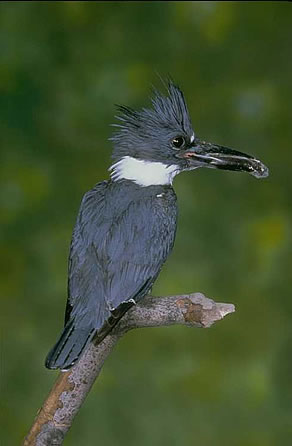 When
the young leave the nest after about one month from hatching, they practice
retrieving fish dropped by their parents. They begin fishing for themselves
after ten days out of the nest. Pairs separate after breeding and defend
individual feeding territories.
When
the young leave the nest after about one month from hatching, they practice
retrieving fish dropped by their parents. They begin fishing for themselves
after ten days out of the nest. Pairs separate after breeding and defend
individual feeding territories.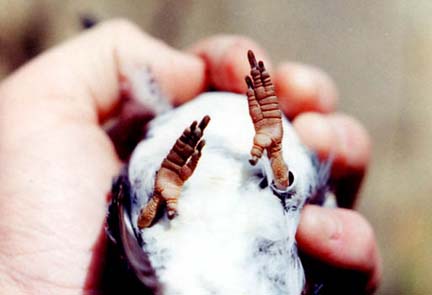 The
Kingfishers belong to an order of birds known as CORACIIFORMES. One
characteristic of this order is syndactyl feet, the outer two toes of
which are joined almost to the end.
The
Kingfishers belong to an order of birds known as CORACIIFORMES. One
characteristic of this order is syndactyl feet, the outer two toes of
which are joined almost to the end.